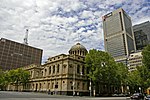County Court of Victoria

The County Court of Victoria is the intermediate court in the Australian state of Victoria. It is equivalent to district courts in the other states. The County Court is the principal trial court in the state, having a broad criminal and civil jurisdiction. The court hears indictable offences (with the exception of murder, manslaughter, and treason), and has unlimited civil jurisdiction, though it generally only hears cases where the statement of claim exceeds the Magistrates' Court limit of $100,000. The court also possesses appellate jurisdiction for cases from the Magistrates' Court, while decisions of the County Court may be appealed to the Supreme Court. With approximately 70 sitting judges, the court hears up to 12,000 cases annually. Peter Kidd was named Chief Judge of the County Court on 8 September 2015.
Excerpt from the Wikipedia article County Court of Victoria (License: CC BY-SA 3.0, Authors, Images).County Court of Victoria
William Street, Melbourne Melbourne
Geographical coordinates (GPS) Address Website Nearby Places Show on map
Geographical coordinates (GPS)
| Latitude | Longitude |
|---|---|
| N -37.8132 ° | E 144.9575 ° |
Address
County Court of Victoria
William Street 250
3000 Melbourne, Melbourne
Victoria, Australia
Open on Google Maps





